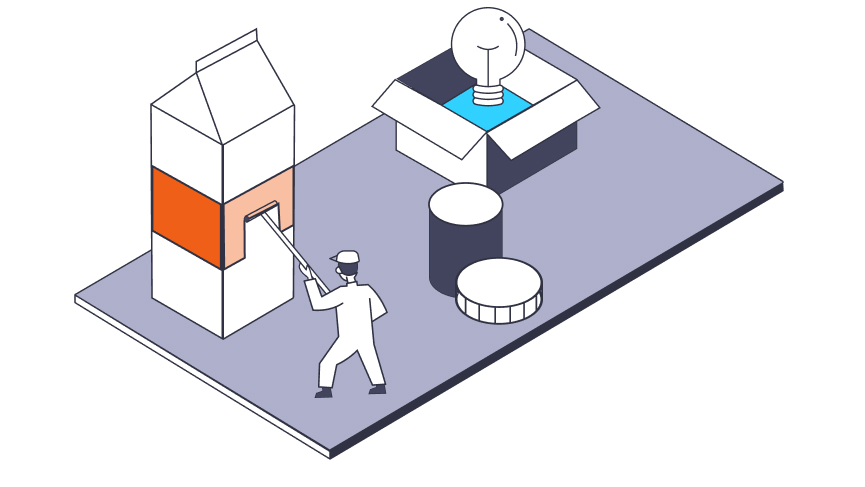The “Agile Manifesto”
The principles of “The Agile Manifesto” brought software development from the traditional waterfall approach to one that is more iterative. Unlike the “waterfall approach” that starts with detailed requirements at the onset, and delivers a tangible product at the end of the process, the Agile approach works in short “sprint” iterations. Each step is intended to generate incremental value and learning.
Another key difference of Agile approach is that there’s a focus on developing a Minimum Viable Product (MVP) as early as possible, by getting a prototype into consumers’ hands, and then responding to their continuous feedback to improve.
With this in mind, can FMCG be Agile too?
The “Agility” of FMCG market
FMCG can indeed be Agile, but some adaptations unique to the dynamics of the industry are required.
First, it’s important to establish that Agile is more than “cheap and fast” development. More than a quarter of BASES clients equate Agile with going faster and cheaper–and they’re not wrong. The Boston Consulting group has done some research to identify as much as a 55% faster timeline to market, and a 25% reduction in costs for clients that adopted Agile over prior methods. However, if we focus only on being fast and cheap in development, it is really easy to cut corners on critical consumer insight; either skipping it or accepting subpar input. When this happens, the MVP misses the mark in creating value for consumers. We see that reflected in our clients’ input on their research processes: although they’re going faster, 1 in 10 say it’s delivering a better outcome in launching better products. Flip that, and you have about 9 in 10 launching products that are neutral or worse.
Second, product development is different in CPG. In software development, Agile means pushing a minimum viable product to a device upfront, and then sending updates as they’re developed in subsequent sprints. The cost of initial failure is small.
For CPG, BASES analysis has revealed that less than 5% of innovations are successful long term when they launch with a subpar product. Here’s why: retailers expect sales from each item on their shelves, and if the sales velocity is not strong enough you get delisted (75% of innovations fail when they are below average in their category velocities). BASES R&D shows that launches typically have a three to six month window to prove themselves before distribution starts to erode on the weak ones.

Is your innovation an MSP?
Want to know more about BASES’ agile solutions?
The Minimum Sustainable Product solution
Launching a product, measuring, learning, innovating, and replacing in flight is just not as feasible in CPG. However, there is a solution. Our view at BASES is that to be Agile in FMCG, the process needs to shift from producing a MVP to a Minimum Sustainable Product (MSP).
MSP is the combination of the right innovation and the right activation that is sustainable enough for your organization, your channel partners, and your consumers according to each one’s goals.
The key is to figure it out in as little time as possible before launch. That doesn’t mean you skip steps or leverage subpar methods. Rather, it means that you become literally Agile in your processes, internalizing and reacting to consumer feedback to truly put their input at the center of your development. With a disciplined approach, you can identify key features and build a functioning product just as fast as in the MVP framework. The MSP mindset keeps us focused on doing the features/prototype testing and optimization safely before launch, to maximize your chances of being sustainable for your channel partners and end consumers.
Having quality research tools that allow you to dependably understand consumer response to your innovations is critical for an Agile approach, and having those tools offer results quickly helps speed through a learning sprint. As the gold standard in the innovation insights industry, BASES has always been able to offer the former; and deep investments in technology have significantly accelerated our delivery without sacrifices in quality or diagnostics. Our digital solutions meet the pace of typical Agile sprints of four to eight weeks, delivering at the pace demanded by the business today.
MSP is the main outcome of Agile in FMCG: the right innovation paired with the right activation that is sustainable for the manufacturer, the consumer, and the channel partner while minimizing time and resources spent.
Methodology
1 NielsenIQ State of Innovation Survey 2017
2 “Agile Works—but Are You Measuring the Impact?”, the Boston Consulting Group – Matthew Aliber, Peter Hildebrandt, Mehran Islam, Andrew Jennings, Erik Lenhard, David Ritter, and Filippo Scognamiglio
3 NielsenIQ State of Innovation Survey 2017
4 NielsenIQ Factors for Success database & Factors Validation analysis
5 NielsenIQ US – Velocity vs. Sustainability Analysis
6 NielsenIQ US – ACV weighted distribution for new products across multiple categories (cold remedy, crackers, dry cat food, facial moisturizer, frozen entrees, laundry, potato chips, shampoo, shelf stable juice or drink, soft drinks, styling aids), 5 year period ending Feb. 2017




